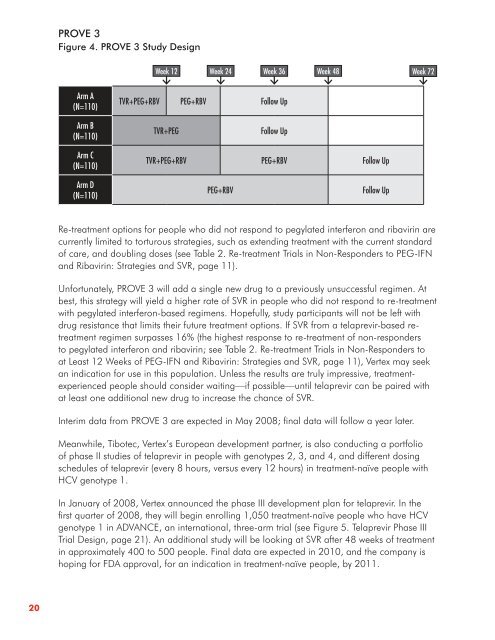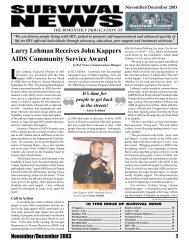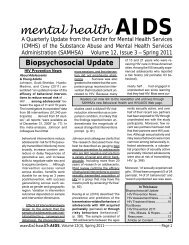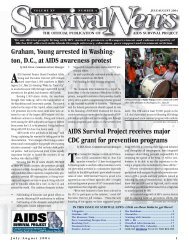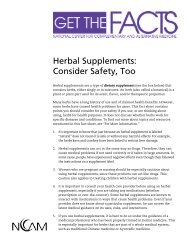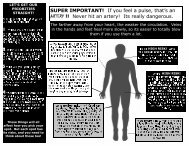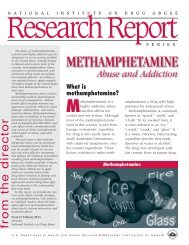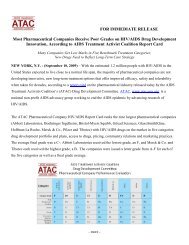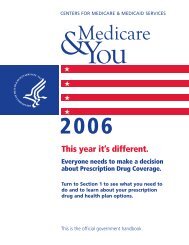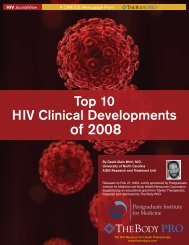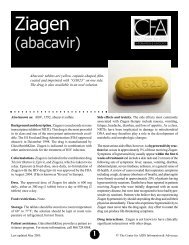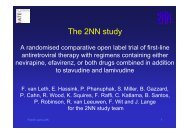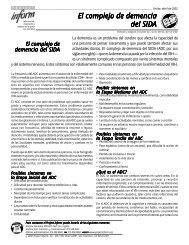Hepatitis C: New Treatments in the Pipeline - CD8 T cells - The Body
Hepatitis C: New Treatments in the Pipeline - CD8 T cells - The Body
Hepatitis C: New Treatments in the Pipeline - CD8 T cells - The Body
You also want an ePaper? Increase the reach of your titles
YUMPU automatically turns print PDFs into web optimized ePapers that Google loves.
20<br />
PROVE 3<br />
Figure 4 . PROVE 3 Study Design<br />
Arm A<br />
(N=110)<br />
Arm B<br />
(N=110)<br />
Arm C<br />
(N=110)<br />
Arm D<br />
(N=110)<br />
Week 12 Week 24 Week 36 Week 48 Week 72<br />
TVR+PEG+RBV PEG+RBV Follow Up<br />
TVR+PEG Follow Up<br />
TVR+PEG+RBV PEG+RBV Follow Up<br />
PEG+RBV Follow Up<br />
Re-treatment options for people who did not respond to pegylated <strong>in</strong>terferon and ribavir<strong>in</strong> are<br />
currently limited to torturous strategies, such as extend<strong>in</strong>g treatment with <strong>the</strong> current standard<br />
of care, and doubl<strong>in</strong>g doses (see Table 2. Re-treatment Trials <strong>in</strong> Non-Responders to PEG-IFN<br />
and Ribavir<strong>in</strong>: Strategies and SVR, page 11).<br />
Unfortunately, PROVE 3 will add a s<strong>in</strong>gle new drug to a previously unsuccessful regimen. At<br />
best, this strategy will yield a higher rate of SVR <strong>in</strong> people who did not respond to re-treatment<br />
with pegylated <strong>in</strong>terferon-based regimens. Hopefully, study participants will not be left with<br />
drug resistance that limits <strong>the</strong>ir future treatment options. If SVR from a telaprevir-based retreatment<br />
regimen surpasses 16% (<strong>the</strong> highest response to re-treatment of non-responders<br />
to pegylated <strong>in</strong>terferon and ribavir<strong>in</strong>; see Table 2. Re-treatment Trials <strong>in</strong> Non-Responders to<br />
at Least 12 Weeks of PEG-IFN and Ribavir<strong>in</strong>: Strategies and SVR, page 11), Vertex may seek<br />
an <strong>in</strong>dication for use <strong>in</strong> this population. Unless <strong>the</strong> results are truly impressive, treatmentexperienced<br />
people should consider wait<strong>in</strong>g—if possible—until telaprevir can be paired with<br />
at least one additional new drug to <strong>in</strong>crease <strong>the</strong> chance of SVR.<br />
Interim data from PROVE 3 are expected <strong>in</strong> May 2008; f<strong>in</strong>al data will follow a year later.<br />
Meanwhile, Tibotec, Vertex’s European development partner, is also conduct<strong>in</strong>g a portfolio<br />
of phase II studies of telaprevir <strong>in</strong> people with genotypes 2, 3, and 4, and different dos<strong>in</strong>g<br />
schedules of telaprevir (every 8 hours, versus every 12 hours) <strong>in</strong> treatment-naïve people with<br />
HCV genotype 1.<br />
In January of 2008, Vertex announced <strong>the</strong> phase III development plan for telaprevir. In <strong>the</strong><br />
first quarter of 2008, <strong>the</strong>y will beg<strong>in</strong> enroll<strong>in</strong>g 1,050 treatment-naïve people who have HCV<br />
genotype 1 <strong>in</strong> ADVANCE, an <strong>in</strong>ternational, three-arm trial (see Figure 5. Telaprevir Phase III<br />
Trial Design, page 21). An additional study will be look<strong>in</strong>g at SVR after 48 weeks of treatment<br />
<strong>in</strong> approximately 400 to 500 people. F<strong>in</strong>al data are expected <strong>in</strong> 2010, and <strong>the</strong> company is<br />
hop<strong>in</strong>g for FDA approval, for an <strong>in</strong>dication <strong>in</strong> treatment-naïve people, by 2011.


